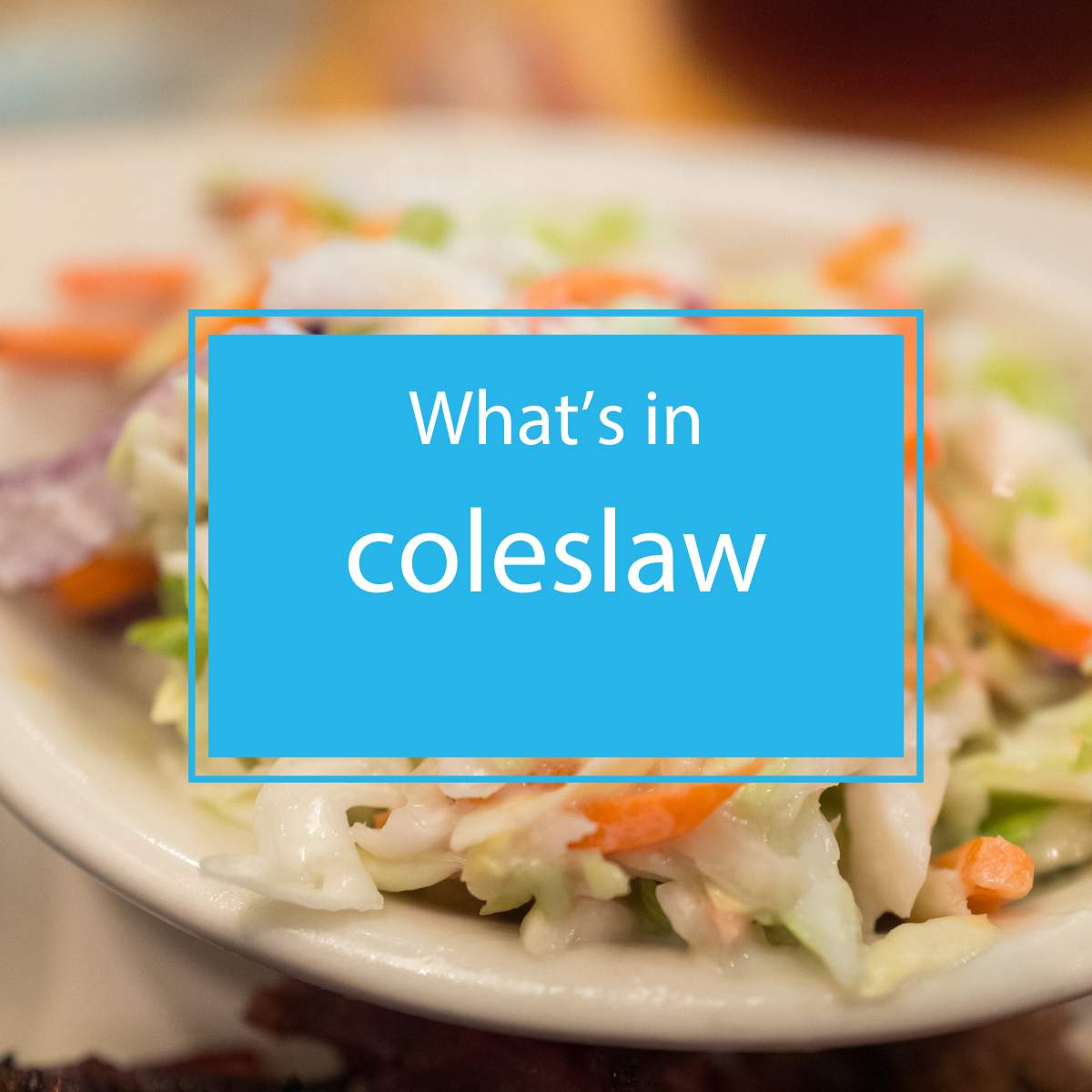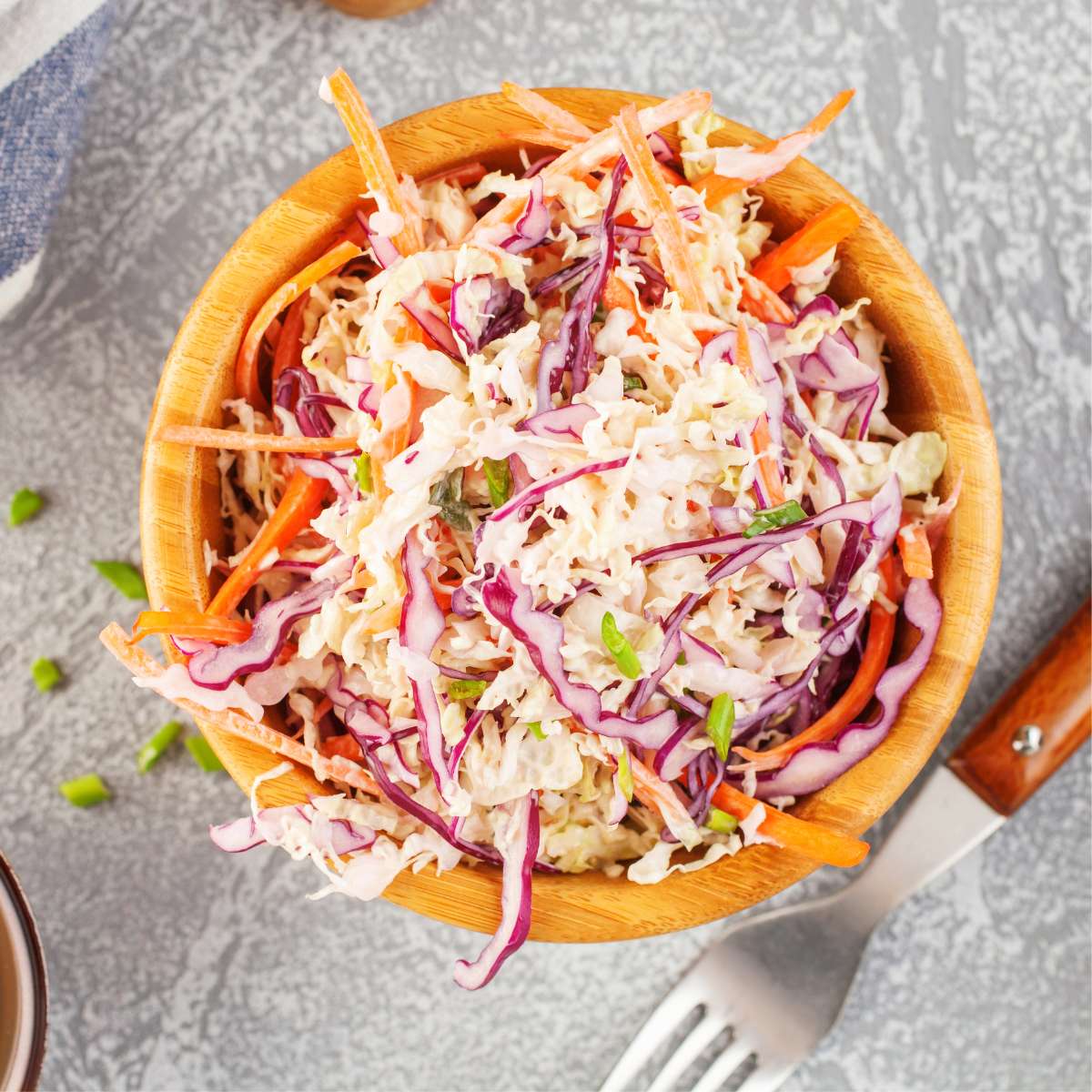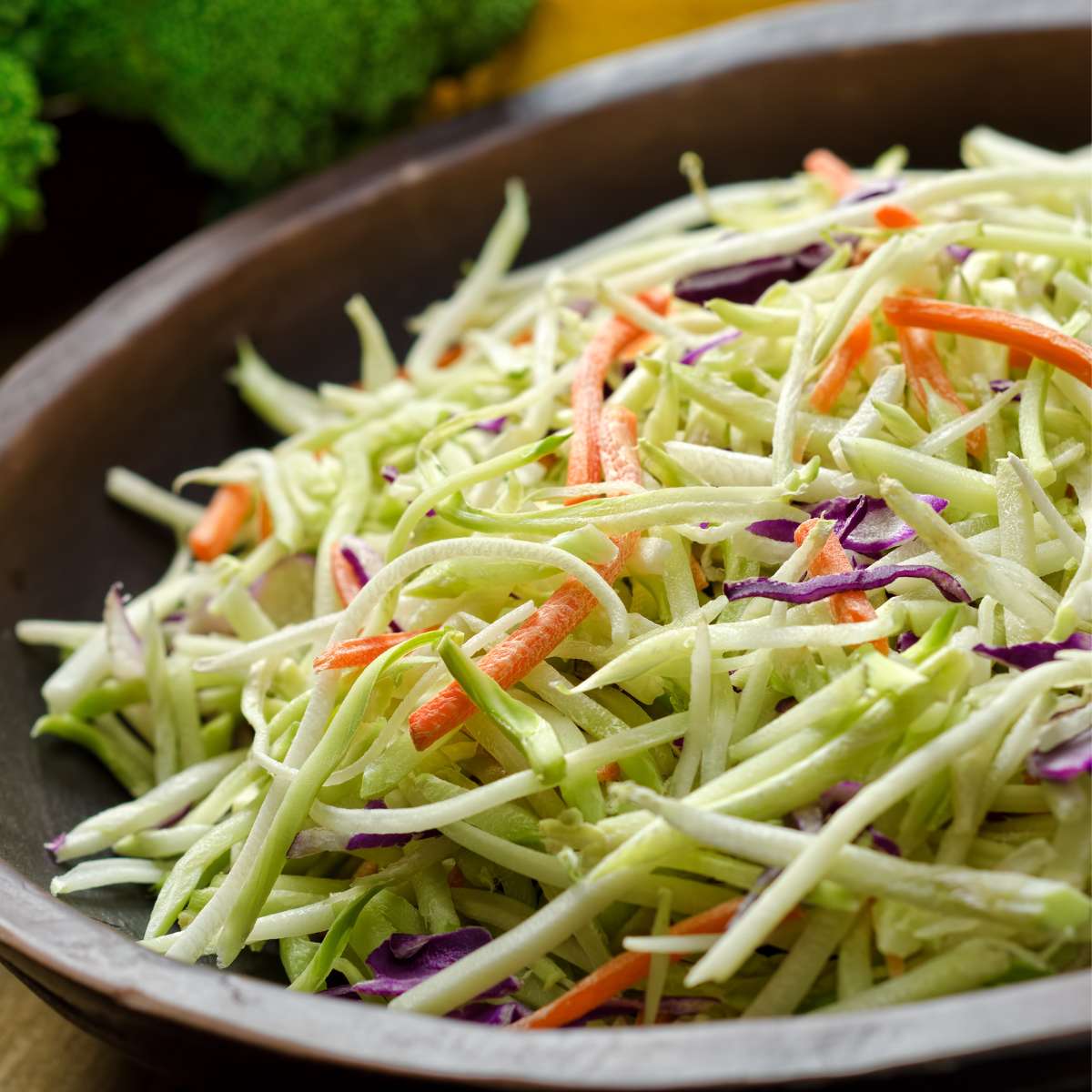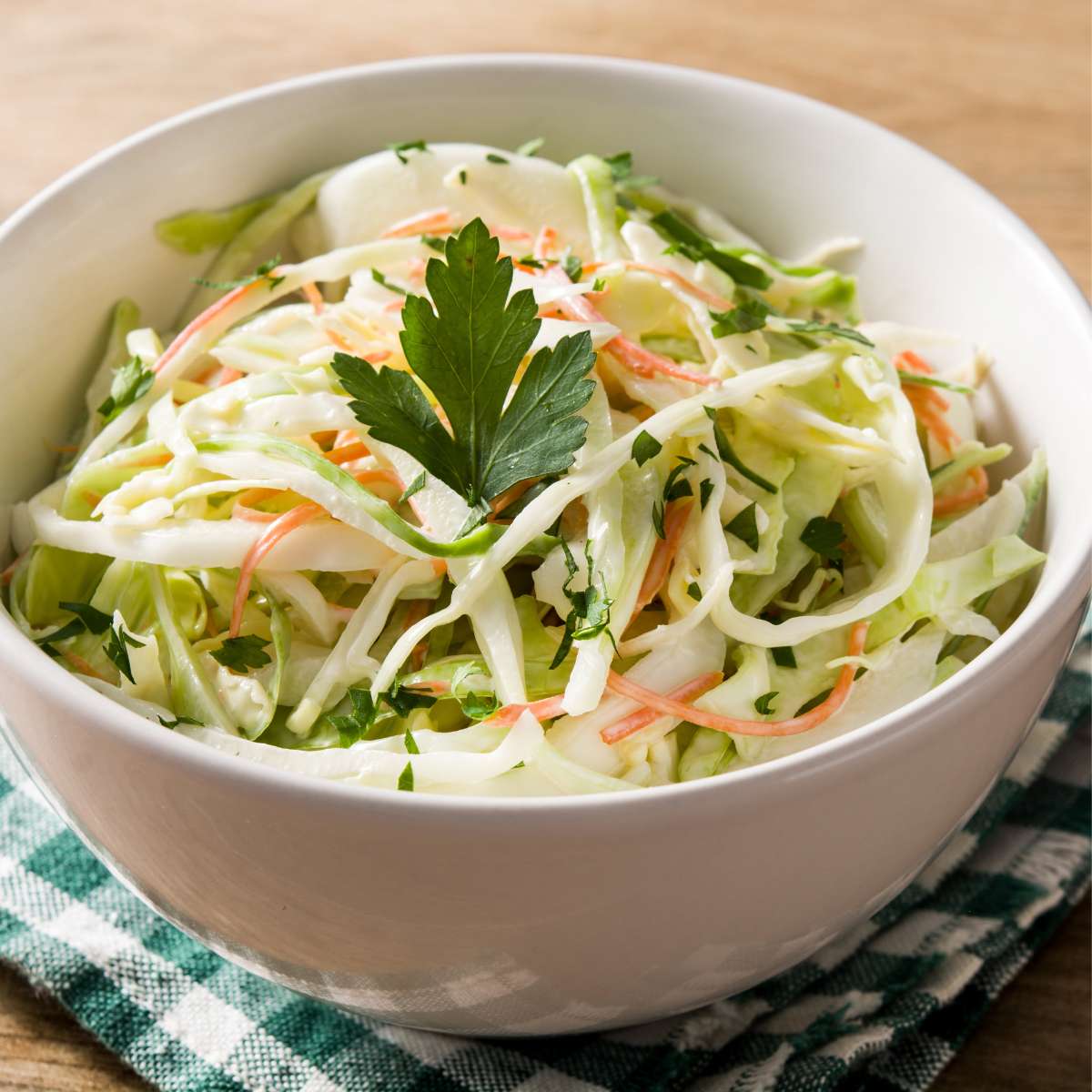What’s in Coleslaw? For those of you longing for a classic side dish that offers a satisfying crunch and unforgettable taste, we have the dish for you: coleslaw. Often considered the ultimate BBQ accompaniment, this timeless salad goes beyond standard backyard fare and offers a medley of flavors and textures.
Let’s explore the key coleslaw components and delightful variations by delving into the world of crunchy coleslaw flavors.
Key Takeaways
- Coleslaw is a versatile classic side dish, perfect as a BBQ accompaniment
- Typical coleslaw components include shredded cabbage, creamy dressing, and sometimes ingredients like carrots
- Sturdy green cabbage and vibrant red cabbage are the most common varieties used
- Coleslaw dressings range from creamy and rich to tangy and vinegar-based
- Experiment with mix-ins such as apples, pineapple, and raisins to heighten flavors and terxtures
- Healthy and international variations exist, showcasing the broad appeal and adaptability of coleslaw
- Proper ingredient selection, balance, and storage are key to achieving perfect coleslaw
A Culinary Staple: The Basic Components of Coleslaw
What’s underneath all that creamy goodness that often makes its appearance at your picnics, potlucks, and summer BBQs? Let’s break down the core coleslaw ingredients that culminate in this refreshing side dish.
While countless variations exist, the foundation of coleslaw remains relatively simple, consisting of shredded cabbage, a creamy dressing often made from mayonnaise, and a touch of sweetness from sugar or other sweeteners.
To truly grasp the side dish essentials, it’s vital to understand the importance of each ingredient. The cabbage, typically finely shredded, provides the base and the unmistakable crunch that coleslaw enthusiasts adore. Its mild flavor offers a blank canvas, allowing the creamy dressing and other ingredients to shine through.
Of course, the dressing plays a significant role in this dish – it binds the cabbage and other components together while also imparting a mouthwatering creaminess that makes coleslaw utterly irresistible.
Adding to the magic, coleslaw usually includes a hint of sweetness balanced with a tangy bite. This delicate balance of sweet and sour creates a perfect harmony of flavors, elevating your coleslaw from a humble cabbage-based salad to an unforgettable must-have at any casual gathering or meal.
It’s the perfect harmony of flavors that makes coleslaw a beloved side dish – a refreshing mix of crunchy, creamy, sweet, and tangy all rolled into one.
So, whether you’re a seasoned slaw aficionado or just starting to explore the world of coleslaw, remember that the foundation of success lies in these three key ingredients: shredded cabbage, a creamy dressing, and a balance of sweet and tangy flavors.
Master these core elements, and you’ll be well on your way to crafting your own version of this delectable side dish. Happy crunching!
The Secret Behind the Crunch: Cabbage Varieties Explained
When it comes to the unforgettable crunch in coleslaw, the type of cabbage you choose plays a significant role. With various cabbage types available, it’s essential to know which ones work best in coleslaw and how they contribute to the dish’s signature texture.
The Contrast of Green and Red Cabbage
Green cabbage is the most common choice in coleslaw recipes, prized for its bright flavor and robust leaves that hold up well under dressings. Its mild taste allows for an optimal balance between the vegetable’s crunch and the dressing’s creamy or tangy flavors.
Red cabbage, on the other hand, offers more than just a vibrant color contrast. Also known as purple cabbage, this variety boasts health benefits such as cholesterol protection and cancer prevention. Its slightly peppery taste adds a bit of pizzazz to your coleslaw, making it a delightful alternative to the traditional green cabbage.
How Cabbage Contributes to Coleslaw’s Signature Texture
What gives cabbage its crunch? The crispiness of cabbage can be attributed to its high water and fiber content, which allows it to retain its firmness even after mixing with dressings. This crispness is essential for a satisfying coleslaw experience, providing the pleasant contrast against the soft and smooth texture of dressings.
So, whether you prefer using green cabbage for its classic taste and sturdy leaves or opt for red cabbage with its vibrant hue and health benefits, the choice ultimately impacts the texture of your coleslaw. In the end, it’s all about finding the perfect balance of crunch and flavor to create a delectable side dish that complements any meal.
The Dressing Makes the Difference: Coleslaw Variations
The magic of coleslaw lies in its versatile dressings, capable of dramatically transforming the taste and texture of this classic salad. Traditionally, mayo-based coleslaw is a popular choice, lending a rich, creamy essence to the dish.
However, vinegar-based slaw offers a tangy alternative that leaves a refreshing, punchy impact on the palate. Whether as Salad Pairings, or exploring various Salad Recipes, coleslaw’s adaptability makes it a delightful addition to diverse culinary experiences.
“The right dressing can turn your coleslaw from ordinary to extraordinary.”
For those seeking a creative twist, numerous innovative dressing variations are at your disposal. Infuse your coleslaw dressing with mustard for a zesty kick, or add celery seeds for a subtle, earthy flavor. If your taste buds prefer a hint of sweetness, consider incorporating sweet condensed milk into the mix for a unique and delightful spin on the classic recipe.
To help you decide between creamy and tangy flavors, consider the following comparisons:
| Coleslaw Dressing Type | Characteristics | Best Paired With |
|---|---|---|
| Mayo-Based | Creamy, rich, and smooth | Heavy, smoky dishes like BBQ or fried chicken |
| Vinegar-Based | Tangy, acidic, and refreshing | Light, crisp meals like sandwiches or seafood |
Ultimately, the choice is yours. Whether you prefer a luscious, mayo-based coleslaw or a snappy, vinegar-based slaw, there is no wrong answer. Embrace your culinary creativity and experiment with different combinations to discover your perfect coleslaw dressing match.
Sweet and Tangy Additions: Exploring Coleslaw Mix-Ins
Customizing your coleslaw with various coleslaw mix-ins allows for exciting combinations of flavors and textures. Traditionally, carrots are added to enhance the sweetness and boost the crunchy texture. However, there are several other delightful coleslaw ingredient variations that you can experiment with to put a unique spin on this classic side dish.

For a touch of fruity sweetness and a burst of vibrant crispness, you can include tangy apples in your coleslaw recipe. Fuji apples, in particular, are perfect for this purpose. On the other hand, if you’re craving something tropical, look no further than pineapple chunks.
The addition of pineapples promises a delicious combination of tang and sweetness that complements the coleslaw dressing perfectly.
Sweet raisins are another excellent mix-in to consider. They not only lend a pleasant contrast of chewy texture but also work well with both creamy and tangy dressings. Experiment with different mix-ins to find your favorite combinations and surprise your guests with a creative and unique twist on the classic coleslaw dish.
| Mix-in | Flavor | Texture |
|---|---|---|
| Carrots | Sweet | Crunchy |
| Fuji Apples | Tangy and Sweet | Crisp |
| Pineapple | Tropical Tang | Juicy |
| Raisins | Sweet | Chewy |
In conclusion, personalizing your coleslaw with a variety of mix-ins can elevate a simple dish to new heights. From fruity tanginess to sweet chewiness, the sky’s the limit when it comes to coleslaw creativity. So go ahead, mix and match your favorite flavors and textures, and let your unique coleslaw become the talk of the table.
Making it Healthy: Nutritious Twists on Traditional Coleslaw
Contemporary coleslaw recipes have increasingly focused on improving the dish’s nutritional value by reducing or even eliminating mayonnaise from the dressing, resulting in a lighter, more wholesome side dish option.
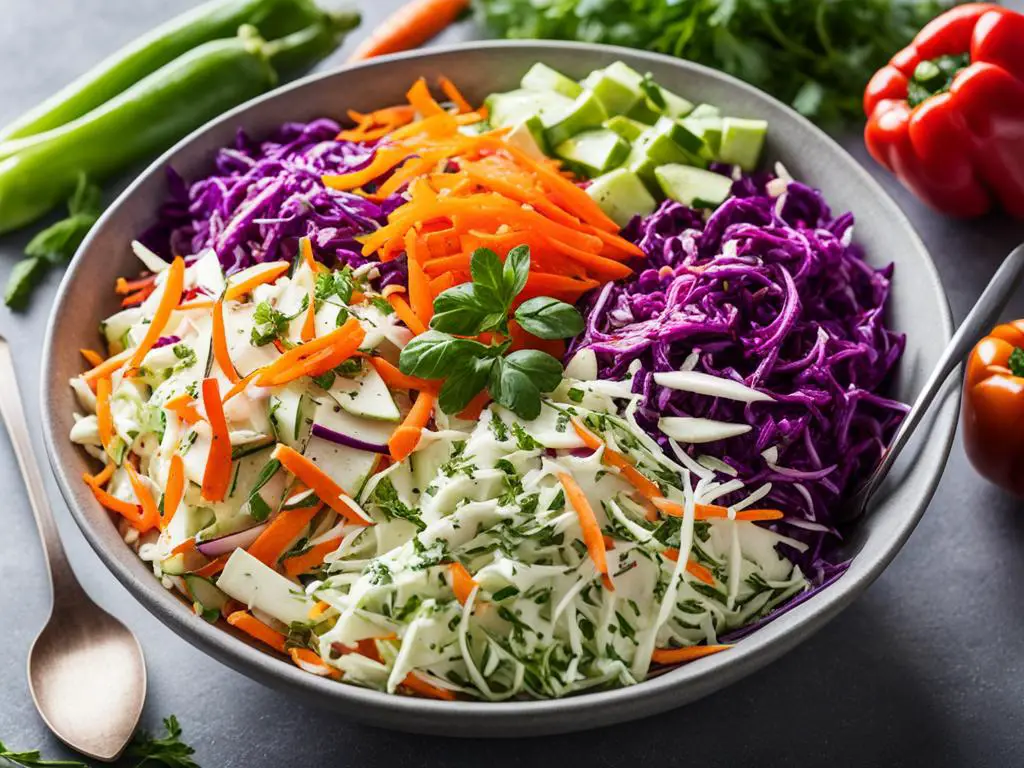
Healthy coleslaw recipes now offer mayo-free dressings and nutrient-packed superfoods for those looking to incorporate health-conscious meals into their daily routine.
The Rise of Mayo-Free Coleslaw
Mayo-free dressings have gained popularity as an alternative to traditional coleslaw preparations. These dressings not only cut down on calories and fat but also add a refreshing twist to the classic dish.
Some healthy coleslaw recipes feature lemony Greek-style dressings, while others employ Italian vinaigrettes for a burst of tanginess that elevates the taste and presentation of the slaw.
Incorporating Superfoods into Your Slaw
Upgrading your coleslaw by adding superfoods can transform it into a nutrient-packed side dish that still delivers on crunch and taste. Nutritious ingredients such as chickpeas, kalamata olives, and a mix of brightly colored vegetables can take your slaw to the next level.
These superfoods not only boost the nutritional content of the coleslaw but also add unique flavors and textures that are sure to delight both new and old fans of this classic dish.
What’s in Coleslaw: A Guide to Making Your Own
Creating a delicious DIY coleslaw is not only satisfying but also allows you to control the quality and customize the flavors to your liking. By following this guide, you’ll be able to prepare the perfect coleslaw using fresh coleslaw ingredients and a homemade dressing that suits your palate.
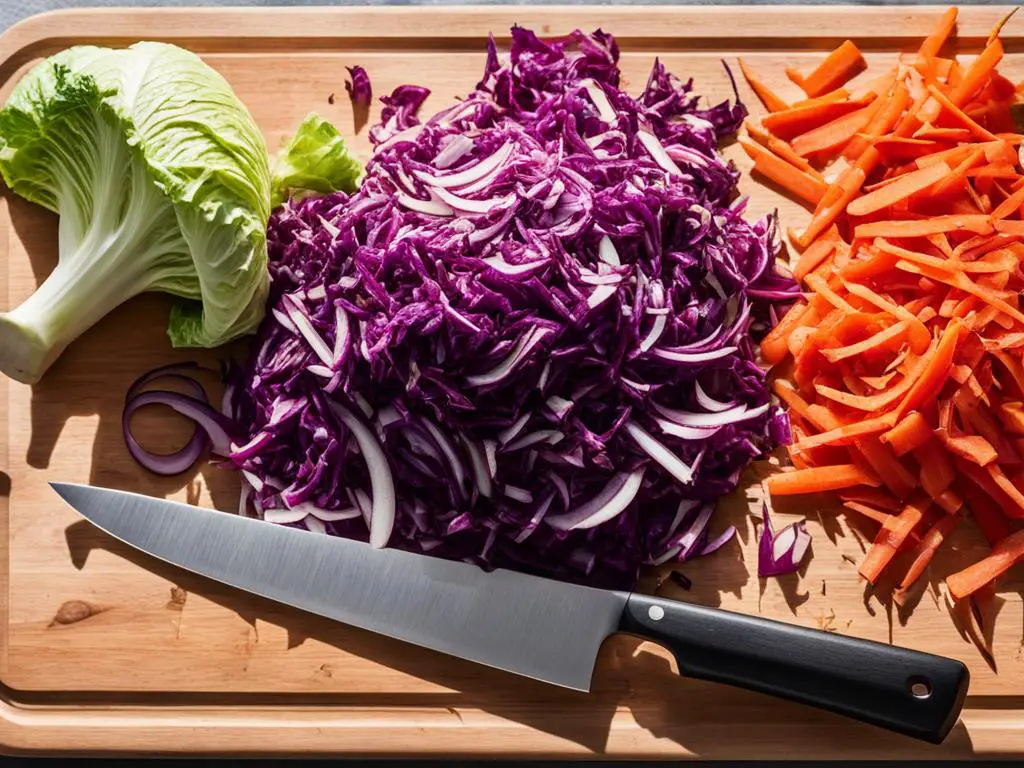
Selecting the Fresh Ingredients
It’s essential to start with fresh, high-quality cabbage and other vegetables, as they lay the foundation for a flavorful and crunchy coleslaw. Opt for crisp, vibrant green or red cabbage, and complement them with additional vegetables like carrots, bell peppers, or even fruits such as apples or pineapple for an exciting twist.
The key to an outstanding coleslaw is attentiveness to each ingredient’s freshness and quality, which ensures maximum flavor and crunch in your coleslaw preparation.
The Art of Dressing: Creamy vs. Vinegar-Based
Next, decide on the type of dressing that matches your taste preferences, whether creamy or vinegar-based. For a rich, indulgent coleslaw, consider mixing mayonnaise with sour cream, sugar, or honey as your homemade dressing base. In contrast, if you prefer a lighter, tangier slaw, vinegar-based dressings will be your best fit.
A simple vinaigrette, combining vinegar, oil, sugar, and seasonings, can create a refreshing contrast to the crunchy vegetables. Additionally, don’t be afraid to experiment with additional flavors, such as mustard, yogurt, or fresh herbs, for a personalized touch.
With these guidelines in mind, you’ll be well on your way to mastering the art of coleslaw making. Remember, the key is to use fresh, quality ingredients and a homemade dressing that caters to your taste preferences, resulting in a delightful side dish that’s uniquely yours.
Coleslaw: A Delight in Every Bite
The flavor profile coleslaw is known for entices the taste buds with every forkful. Whether you prefer a creamy dressing or a tangy alternative, coleslaw offers an array of tastes and combinations to suit any preference. This side dish delight can be customized to fit a multitude of dishes, making it an all-time favorite.
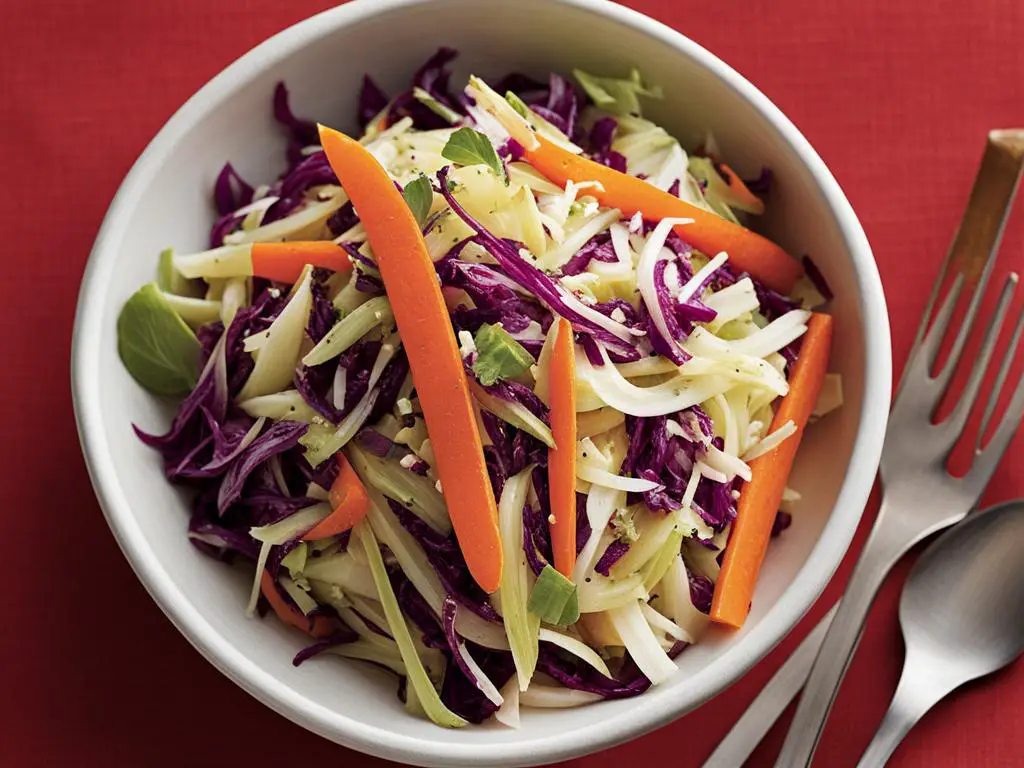
At the heart of every coleslaw recipe lies a crunchy vegetable mix, traditionally composed of shredded cabbage and carrots. It’s this intricacy in textures and flavors that makes coleslaw an exceptional side dish. The combinations are endless, so there’s always something new to try and explore when it comes to this versatile salad.
Consider the following ways to enjoy coleslaw:
- Pair it with a creamy dressing for a rich, indulgent side dish.
- Experiment with a tangy dressing packed with acidity for a refreshing palate cleanser.
- Add in fruit, nuts, or seeds for bursts of flavor and added crunch.
- Transform it into a hearty, healthy meal with the addition of legumes, olives, or cooked proteins.
Whichever variation you choose, coleslaw’s harmonious blend of ingredients ensures it remains a popular choice for meals of all occasions, from family gatherings to backyard barbecues. Indulge in the delightful crunch and complex flavors of coleslaw, and let it take your taste buds on a memorable culinary journey.
The Global Take on Coleslaw: International Varieties
As a delicious side dish, coleslaw has gained popularity across the globe, inspiring various international coleslaw recipes. By incorporating unique ingredients, exotic spices, and alternative dressings, coleslaw around the world showcases a wide range of flavors that reflect the diverse culinary traditions and palates of specific regions.
Let’s explore some of these enticing exotic slaw variations that will leave you eager to broaden your coleslaw horizons.
- German Coleslaw: Also known as Krautsalat, this German version uses a vinegar-based dressing with mustard and caraway seeds for distinct tangy flavors.
- Asian Slaw: This colorful coleslaw incorporates ingredients such as red cabbage, green onions, carrots, and toasted sesame seeds. The dressing typically features rice wine vinegar, soy sauce, ginger, and sesame oil, resulting in a bright and savory taste.
- Mexican Jicama Slaw: This refreshing variation swaps traditional cabbage with jicama and adds flavors like cilantro, lime, and jalapeño peppers for a zesty twist.
- Caribbean Coleslaw: With ingredients like mango, pineapple, and red pepper, Caribbean coleslaw offers a fruity and vibrant taste complimented by a citrus dressing.
- Middle Eastern Coleslaw: This version elevates the classic coleslaw with ingredients like mint, parsley, and pomegranate seeds, along with a tahini-based dressing for a unique and bold flavor profile.
Experimenting with international coleslaw recipes is a fantastic way to experience the diverse flavors and textures of coleslaw preparations from various cultures and culinary traditions. As you embark on your global coleslaw adventure, you’ll no doubt develop a newfound appreciation for this versatile and delicious side dish.
From Side to Main Course: Creative Ways to Serve Coleslaw
Coleslaw, traditionally served as a side dish, can easily take the center stage in a variety of meals. With a few imaginative tweaks, inventive coleslaw serving ideas are waiting to elevate your dishes and impress your guests while keeping the classic crunch we all love.
Fulfilling a coleslaw’s gastronomic potential often entails coleslaw as a topping or transforming it into a main course.
Coleslaw as a Topping
Think beyond the side dish, and layer slaw toppings onto your sandwiches or wraps for extra flavor and texture. As a crown above pulled pork or grilled chicken, coleslaw adds a refreshing crunch that complements the meat perfectly. It also works wonderfully as a topping for hot dogs, burgers, and fish tacos, creating a harmonious blend of tastes with each bite.
Transforming Coleslaw into a Meal
Let coleslaw be the star of the show by incorporating protein-rich ingredients that transform it into a coleslaw main dish. For a wholesome and nutritious option, consider adding chickpeas, grilled chicken, or shrimp to your coleslaw.
Incorporating quinoa or farro can provide a satisfyingly hearty texture, perfect for powering through your day. Serve your dazzling coleslaw meal inside pita pockets or atop a bed of mixed greens for a unique and mouthwatering twist on the classic recipe.
Whether as a topping or transformed into a main course, coleslaw can be versatile, flavorful, and ever so satisfying. So go ahead, explore the world of coleslaw meals and see how far this classic side dish can take you!
Expert Tips for the Perfect Coleslaw Balance
Achieving a perfectly balanced coleslaw involves a combination of precise ingredient measurements, freshness of produce, and allowing flavors to meld before serving. To perfect your coleslaw and ensure a satisfying crunch in every bite, follow these expert tips:

- Drain excess liquid from cabbage: Remove any excess moisture from the cabbage by patting it dry with paper towels or using a salad spinner. This prevents the coleslaw from becoming watery and preserves the crisp texture of the vegetables.
- Measure seasonings carefully: Consistency in flavor is key to coleslaw perfection. Precisely measure the seasonings like salt, sugar, and spices to ensure a cohesive taste throughout the dish.
- Refrigerate before serving: To intensify the taste and ensure the vegetables remain crisp, refrigerate the coleslaw for a few hours before serving. This allows the flavors to meld together and enhances the overall taste of the dish.
- Balance flavors: A harmonious coleslaw has a delicate balance of flavors. Adjust the levels of sweetness, tanginess, and creaminess to create a dish that caters to your personal preferences.
In addition to these tips, consider incorporating unique ingredients and variations to create a coleslaw that satisfies your taste buds, offering a mouth-watering experience in every forkful. Check out the following table for some popular coleslaw variations and their key ingredients:
| Variation | Key Ingredients |
|---|---|
| Traditional Creamy Coleslaw | Shredded cabbage, mayonnaise, sugar |
| Tangy Vinegar-Based Slaw | Shredded cabbage, vinegar, sugar, oil |
| Asian-Style Slaw | Shredded cabbage, carrots, green onions, sesame oil, rice vinegar, soy sauce |
| Southwest-Style Slaw with Creamy Avocado Dressing | Shredded cabbage, corn, black beans, avocado, lime juice, cilantro, sour cream |
Remember, perfecting coleslaw is all about finding the right balance of flavors and textures to suit your preferences. With these expert tips and a little creativity, you’ll be mastering the art of coleslaw in no time.
Preserving the Peak: Storing Coleslaw for Freshness
Proper coleslaw storage is crucial for maintaining the freshness and crunchiness of your favorite side dish. Understanding how to preserve coleslaw appropriately will make all the difference when it comes to relishing its optimal flavors and textures. So, buckle up and let’s dive into the guidelines for coleslaw refrigerator shelf life and its essence in preserving your slaw.
Begin by storing your coleslaw in a tightly sealed container to prevent contamination and drying out. The key to preserving coleslaw and maintaining freshness is ensuring you place it in the refrigerator, where it’s better protected from unwanted external factors.
| Storage Method | Recommended Storage Time | Effect on Taste and Texture |
|---|---|---|
| Refrigerator – Sealed Container | 2-3 Days | Optimal flavors and textures |
| Refrigerator – Loosely Wrapped | 1 Day | Potential loss of crunch and vibrancy |
| Unrefrigerated | 1-2 Hours | Not recommended, potential contamination and dehydration |
As seen in the table above, coleslaw’s ideal refrigerator shelf life is between 2 to 3 days. Storing it any longer may result in a loss of crunch and vibrancy, which diminishes the overall enjoyment of the dish. It is highly advised against leaving coleslaw unrefrigerated for more than one or two hours.
“When life gives you cabbage, make coleslaw – but don’t forget to store it properly.”
In conclusion, by following these straightforward guidelines, you’ll be a master at preserving coleslaw and ensuring that it remains a delicious and crunchy delight for you and your guests. Go forth and store your coleslaw like a pro!
Conclusion
In conclusion, the coleslaw enjoyment you experience is a testament to the adaptability and richness of this ultimate side dish. From its humble beginnings as a mixture of shredded cabbage and creamy dressing, coleslaw has evolved into a diverse smorgasbord of flavors and textures sure to please any palate.
As you conclude your coleslaw guide, remember that this classic side dish is not one-size-fits-all. With various options from traditional creamy salads to tangy slaws with international influences, there is a coleslaw variant tailor-fit to your preferences and dietary needs.
Incorporate the expert tips and variations outlined throughout this article to elevate your coleslaw experience at mealtime gatherings and quiet dinners alike.
Ultimately, it is your mastery of the many tips and inventive recipes available that will keep this well-loved side dish an ongoing highlight in your culinary repertoire. So go forth and enjoy the diverse delights of coleslaw, knowing that you are a connoisseur of this celebrated, versatile classic.
FAQ
What are the basic components of coleslaw?
The essential coleslaw components include shredded cabbage, a creamy dressing typically made with mayonnaise, and often a hint of sweetness via sugar or other sweeteners.
What types of cabbage are commonly used in coleslaw?
The common choice for coleslaw is green cabbage, appreciated for its bright flavor and sturdy leaves. Red cabbage, often labeled as purple cabbage, can also be used, offering a vibrant color contrast and health benefits.
What are some popular coleslaw dressing variations?
Some prefer a mayo-based dressing for a creamy, rich undertone, while others opt for vinegar-based versions for a punchy, tangy flavor. Creative variations include dressings infused with mustard, celery seeds, or sweet condensed milk.
What mix-ins can be added to enhance coleslaw?
Traditional mix-ins include carrots for sweetness and additional crunch. One can also incorporate fruit elements such as apples and pineapple, as well as raisins for a chewy texture and a burst of sweetness.
How can coleslaw be made healthier?
Contemporary coleslaw recipes often reduce or eliminate mayonnaise from the dressing, opting for lighter alternatives like lemony Greek-style dressing or Italian vinaigrette. Adding superfoods such as chickpeas, kalamata olives, or colorful vegetables can also elevate the nutritional content.
What is the ideal way to store coleslaw?
Coleslaw should be stored in a tightly sealed container in the refrigerator to prevent contamination and drying out. It is best consumed within 2 to 3 days to maintain optimal flavors and textures.
What are some unique ways to serve coleslaw?
Coleslaw can be used as a topping on sandwiches, such as pulled pork, or transformed into a nutritious main course by incorporating protein-rich ingredients like chickpeas, chicken, or shrimp and serving it in pita pockets.
